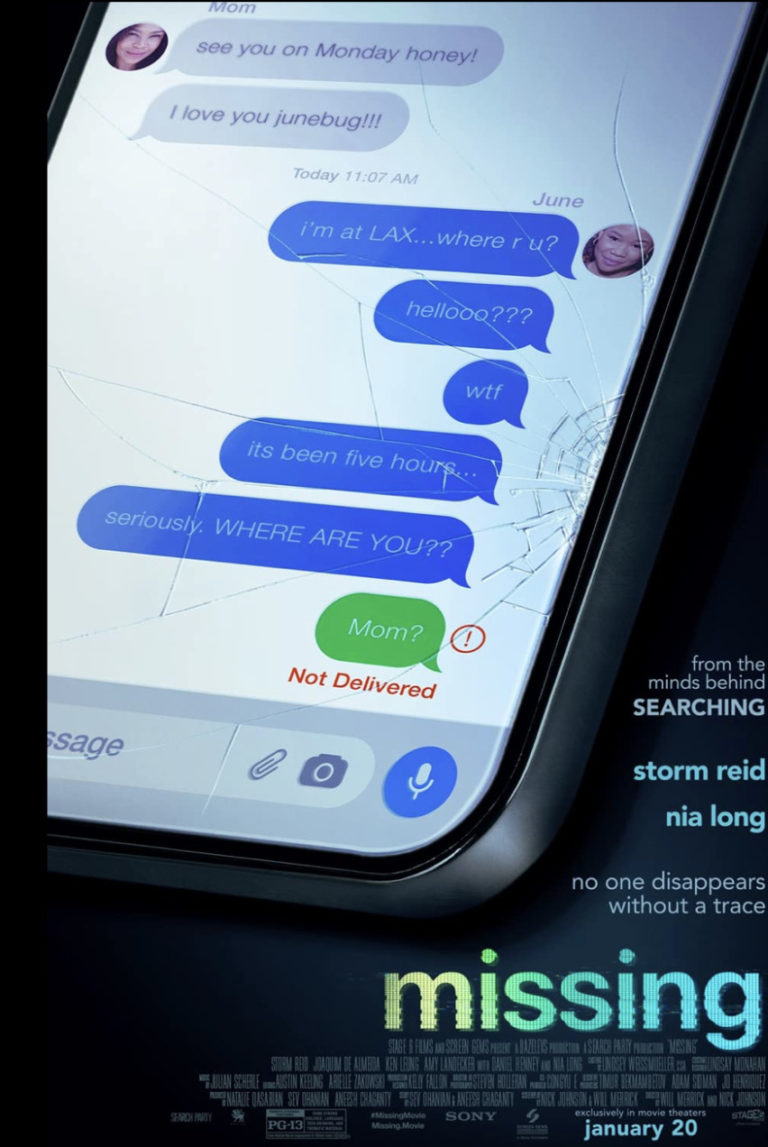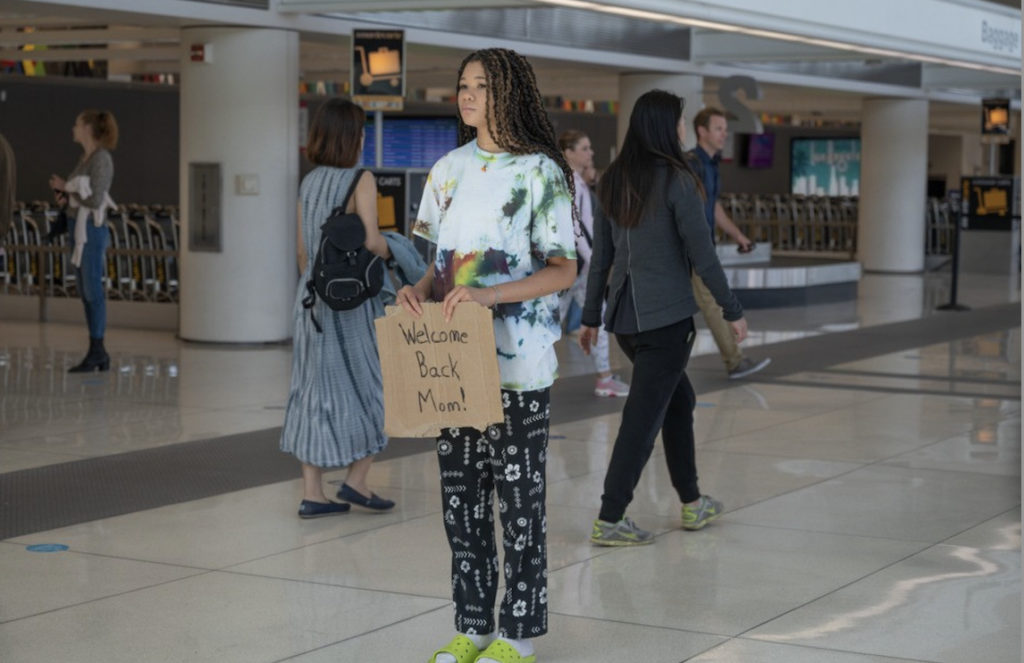
Synopsis : When her mother (Nia Long) disappears while on vacation in Colombia with her new boyfriend, June’s (Storm Reid) search for answers is hindered by international red tape. Stuck thousands of miles away in Los Angeles, June creatively uses all the latest technology at her fingertips to try and find her before it’s too late. But as she digs deeper, her digital sleuthing raises more questions than answers… and when June unravels secrets about her mom, she discovers that she never really knew her at all.

Exclusive Interview with Co-Writer and Producer Aneesh Chaganty
Q: You used to work at Google. How did you make the transition to the film industry?
AC: Luck. I was making commercials at Google. I wasn’t anywhere near there; I was in their New York offices, at this place called the Creative Lab. Their job was to look around at Google and tell stories with their products, basically — at least my job was. So I was always, “Okay, Google Translate: what emotional commercial can I make with that?” And Google Search: “what can you do?”
So I learned, in a way, the first tests of what “Searching” [the movie] would be because I was telling these very emotional stories, or trying to, using screens and buttons and on my Google prompts and whatnot. And that essentially ended up being those first lessons that I learned. I was able to take to “Searching”, which nobody knew was going to be anything when we were working on it.
I quit my job and made this movie because a financier told us they’d fund it. That movie cost $800,000 to make, and it ended up grossing like $75 million — off of just this random idea that we all had that maybe you could tell a full movie on a computer screen. So with that jump, we [made] “Searching”, and then “Searching” was the beginning of my directing career, my film career, so that jump was very, very important. But Google [was] the most important period of learning.
Q: With “Searching”, you and Sev Ohanian did something completely new by having most of the action taking place in the computer. This concept for “Missing” is similar to that and it could almost be seen as a stand-alone sequel. What were the concerns for this film when choosing to do things differently from “Searching”?
AC: Yeah, that’s a great question. At the end of the day, everyone’s mouth looks the same on a Mac — the bars on the bottom, the top — we all use essentially the same UI on a daily basis. So it was a huge concern that this movie wouldn’t look and feel any different from “Searching”. We needed to feel that way.
It was when Sev came up with the idea of switching the main characters, like, what if this movie was about a daughter who is looking for a missing parent? And suddenly we realized that there’s so much energy and excitement in that approach, because the way that a teenager uses a device is completely different from the way John Cho in “Searching” would have done it. He was going into the foreign land that was the Internet.
For our character in “Missing”, the Internet is not a foreign land at all. It’s something that she can do like that [snaps], and that informs our style. We immediately answered the question of how does this look and feel different? Well, it’s because our protagonist is now a teenager, so everything is happening way quicker, we’re not teaching people anything. It just has this energy that actually comes from the story.
Q: You shot several cameras for “Searching”. Each had a different technical approach, such as a Go-Pro, a drone, and even an old camcorder, so shooting was very unconventional. Can you talk about shooting “Missing” with the different technologies you used? How did the crew adapt to using all that technology?
AC: Yeah, we learned a lot making “Searching” with a lot of mistakes, essentially. But the one tenet we kept similar between “Searching” and “Missing” was that we wanted to make a movie where, if we were presenting it like [an] iPhone, we shot it on iPhone. If we were presenting it like a camcorder, we shot it on camcorder. If we were presenting on a GoPro or a video camera, we shot it on those cameras. That, essentially, was the goal of both films: to always be authentic.
So the only ones that were really weird in this film was like a watch sequence in this film. There’s an entire sequence that takes place from a watch, and the watch has a camera on it. That was like taping stuff to a phone, like Storm Reid walking around like this [gestures] being like this [gestures] — and trying to act all natural.
But the beauty of these films is everybody is re-learning their jobs when they’re making them. No one’s lighting the same, because you want it to actually look bad sometimes. Or like our normal lighting on a daily basis, no cinematographer would do this. You want to make everything look intentionally normal. So everybody at every stage of this movie is learning new things. That’s only increased with this sequel.

Q: Even though this is only a story and co-written by Nick Johnson and Will Merrick, what led you to have them co-direct it instead of directing it yourself?
AC: Well, you can ask Will and Nick this right now. But no director who ever makes a movie on a computer screen wants to do it again. This movie is so much work and headache to make. People sometimes think this movie is so easy to make — no, it’s not. This is like, four years in front of every frame is created, every part of the frame is created, on Photoshop and Illustrator, InDesign and After Effects, and rendered. We add color, and we add lens flares and lens blurs and camera shake. It’s so much work.
And on top of that, you can change everything. At any moment you can go “Ah, maybe there’s another tech that we need, another scene that we need. It’s constant experimentation, and you end up working on this movie for — it feels like your whole life. Will and Nick just finished the movie at 3 a.m. yesterday, and they’ve been working on it for so, so long, along with Nat [Natalie Qasabian, co-producer], who’s been there every single day.
There’s a sense of exhaustion that comes with making a movie like this that no director wants to do twice. So immediately when the opportunity that we were making a sequel or follow-up came up, I was like, we’re giving this movie to another group of filmmakers who knows exactly what they’re doing. Will and Nick edited “Searching” — they were there from the beginning of that film. I’ve known them since film school and it was a no-brainer to us to have them direct and write the movie. So we all just played musical chairs and switched seats, and continued to make a sequel.
Q: This film was very well-planned ahead of time. Was there any wiggle room to do any improvisation or unexpected things which just came up that could be added to the film?
AC: Yeah, it’s very, very planned. It’s so planned that we had to make the movie — just like we did with “Searching” — with Will and Nick playing all the characters and all the friends, and we made that movie before we even shot the movie, to know where the cameras would be. One of the beauties and the cons of this film is that everything has to be so planned.
There was wiggle room from a performance standpoint. Sometimes there would be discoveries, or actions or emotions, and dialogue written that felt very real and character-based, that would cause them to change things on the fly. There’s more flexibility in post, when you realize like, okay, let’s just add another scene. And we’re like, okay, this character is texting this character. So there’s improv in that way, but from an acting standpoint there’s a limited window. You can still improvise, but there [were] very strict parameters for improvisation in these movies.
Q: Some parents are conscious of the negative aspects of technology because of what they have heard in the media. But people are able to contact family and friends through such apps as FaceTime and Messenger so there’s really a positive side to it. What are your thoughts on that, and how did you want to reflect those technologies in this film?
AC: Yeah, it’s similar to “Searching”. I feel like technology is so often portrayed very negatively in storytelling. Whether it’s “Black Mirror” [TV series 2011-2019], or even “M3gan” [dir. Gerard Johnstone], which is a story about an android toy that wreaks havoc on a home. It’s very easy to take technology to its scariest dystopian extreme. But the truth is, it’s just a tool. It’s like a hammer can be used for hammering a nail on a door or it can be used to hurt somebody.
I was always interested, and I think this came from my time at Google when “Searching” came out. There’s a lot of good uses for technology, too. It’s just a matter of how much we use it. It’s making a balance of both. We didn’t really try to do that in “Missing”, but the truth is, when you just tell a story on the internet authentically, it will come off that way no matter what. Because good things happen and bad things happen.
Q: Thank you.

Check out more of Nobuhiro’s articles.
Here’s the trailer of the film.


[…] In “Missing,” our protagonist is not a worried father (Cho) finding his feet online, but teenager June (Storm Reid), who is searching for an online friend after her mother Grace (Nia Long) doesn’t return from a Colombian vacation. starts checking. According to Chaganti, it was producer Sev Ohanian who initially thought of the angle to reverse the roles (via Cinema Daily US, […]